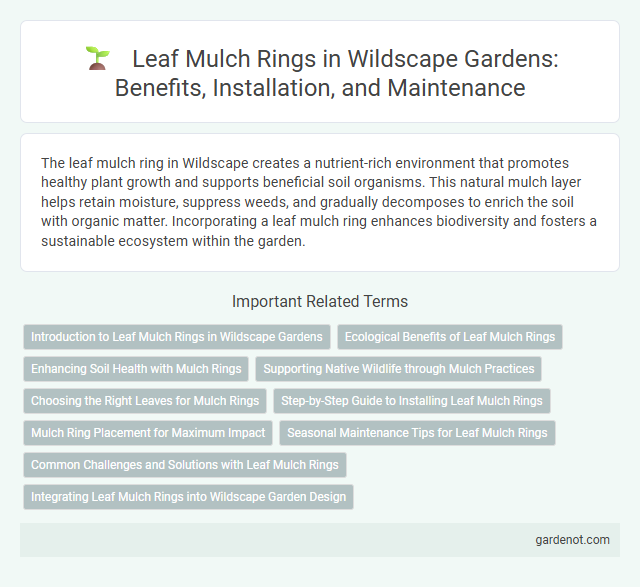The leaf mulch ring in Wildscape creates a nutrient-rich environment that promotes healthy plant growth and supports beneficial soil organisms. This natural mulch layer helps retain moisture, suppress weeds, and gradually decomposes to enrich the soil with organic matter. Incorporating a leaf mulch ring enhances biodiversity and fosters a sustainable ecosystem within the garden.
Introduction to Leaf Mulch Rings in Wildscape Gardens
Leaf mulch rings in Wildscape gardens create a protective, nutrient-rich barrier around trees and plants by utilizing decomposed leaves. These rings enhance soil moisture retention, suppress weed growth, and improve soil fertility through organic matter integration. Implementing leaf mulch rings supports sustainable ecosystem health while promoting diverse native plant growth in naturalized garden settings.
Ecological Benefits of Leaf Mulch Rings
Leaf mulch rings enhance soil health by improving moisture retention and nutrient cycling, promoting robust plant growth in wildscape gardens. They create a habitat for beneficial microorganisms and insects, fostering biodiversity and natural pest control. This organic layer reduces erosion and suppresses weeds, supporting sustainable wildscape ecosystems.
Enhancing Soil Health with Mulch Rings
Leaf mulch rings create a nutrient-rich environment that improves soil structure and moisture retention, promoting healthier root systems. By decomposing gradually, these mulch rings release essential organic matter, boosting microbial activity and enhancing soil fertility. Implementing leaf mulch rings in wildscapes supports sustainable plant growth and reduces erosion by stabilizing soil around trees and shrubs.
Supporting Native Wildlife through Mulch Practices
Leaf mulch rings provide essential habitat and shelter for native insects, amphibians, and small mammals, enhancing biodiversity in wildscapes. By retaining moisture and enriching soil quality, these organic mulch layers support native plant growth and encourage beneficial pollinators. Implementing leaf mulch rings helps create a balanced ecosystem, promoting resilience and sustainability in natural landscapes.
Choosing the Right Leaves for Mulch Rings
Selecting the right leaves for a leaf mulch ring is essential for promoting soil health and supporting native wildlife in a wildscape. Opt for deciduous leaves such as oak, maple, and birch, which break down slowly, enriching the soil with nutrients over time. Avoid leaves from allelopathic species like black walnut or those treated with pesticides to ensure a safe and thriving habitat.
Step-by-Step Guide to Installing Leaf Mulch Rings
To install a leaf mulch ring, start by selecting a healthy tree base and clearing the area of debris and weeds. Spread a 2 to 4-inch layer of shredded leaf mulch evenly around the tree, maintaining a 3 to 6-inch gap from the trunk to prevent moisture buildup and rot. Regularly replenish the mulch ring as it decomposes to improve soil fertility, retain moisture, and support tree health in your Wildscape garden.
Mulch Ring Placement for Maximum Impact
Proper mulch ring placement around trees in a wildscape enhances soil moisture retention and temperature regulation, promoting healthier root development. Maintaining a 2 to 3-foot diameter mulch ring, positioned about 3 to 6 inches away from the tree trunk, prevents trunk rot and pest infestations while maximizing beneficial microbial activity. Consistent application of organic materials like shredded leaves or bark within this mulch ring supports nutrient cycling and improves overall plant resilience.
Seasonal Maintenance Tips for Leaf Mulch Rings
Seasonal maintenance of leaf mulch rings involves regularly replenishing the mulch layer to retain moisture and suppress weeds, especially during dry summer months. In early spring, remove any decomposed leaves to prevent mold buildup and improve soil aeration around plant bases. Autumn requires adding fresh leaves to maintain insulation and nutrient cycling, ensuring healthy plant growth throughout the year.
Common Challenges and Solutions with Leaf Mulch Rings
Common challenges with leaf mulch rings include moisture retention issues, pest attraction, and nutrient imbalance in the soil. Proper layering and regular monitoring can prevent fungal growth and enhance decomposing efficiency. Using organic additives and maintaining adequate air circulation supports healthy root systems and reduces pest infestations.
Integrating Leaf Mulch Rings into Wildscape Garden Design
Leaf mulch rings enhance Wildscape garden design by improving soil moisture retention and providing habitat for beneficial insects and microorganisms. These rings promote natural decomposition processes that enrich soil fertility and support native plant growth. Incorporating leaf mulch rings around trees and shrubs fosters a sustainable ecosystem, reducing water demand and encouraging biodiversity.
Leaf mulch ring Infographic

 gardenot.com
gardenot.com